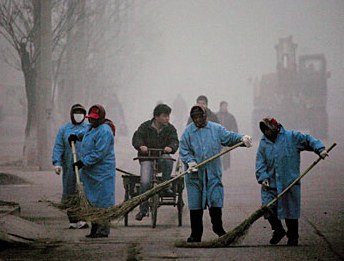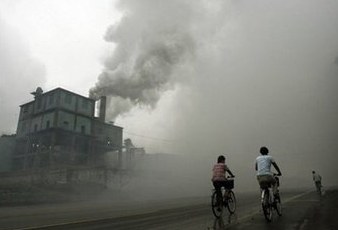A brown
cloud of pollution caused by human activities, three kilometers
thick and stretching from the Arabian Peninsula across Asia
to the western Pacific Ocean, is darkening cities, speeding
the melting of Himalayan glaciers and affecting human health,
finds a new report from the United Nations Environment Programme.
Atmospheric
brown clouds, formed by the burning of fossil fuels, biofuels,
wood and plants, absorb sunlight and heat the air, experts write
in the study released today in Beijing.
The
clouds also mask the actual warming impact of climate change
by anywhere between 20 and 80 percent because they include sulfates
and other chemicals which reflect sunlight and cool the surface,
according to the report.
 Dimming
of between 10 and 25 percent is occurring over Beijing and Shanghai,
in China, Karachi, Pakistan, and New Delhi, India.
Dimming
of between 10 and 25 percent is occurring over Beijing and Shanghai,
in China, Karachi, Pakistan, and New Delhi, India.
Professor
Veerabhadran Ramanathan, head of the UNEP scientific panel carrying
out the research, is based at the Scripps Institution of Oceanography
in La Jolla, California.
The
new report provides confirmation of the atmospheric brown clouds
effects that Ramanathan's research first documented six years
ago.
"Our
preliminary assessment, published in 2002, triggered a great
deal of awareness but also skepticism," he said. "That
has often been the initial reaction to new, novel and far reaching,
counter-intuitive scientific research."
Ramanathan
called for an international response to the report's findings
that "tackles the twin threats of greenhouse gases and
brown clouds and the unsustainable development that underpins
both."
"One
of the most serious problems highlighted in the report is the
documented retreat of the Hind Kush-Himalayan-Tibetan glaciers,
which provide the headwaters for most Asian rivers, and thus
have serious implications for the water and food security of
Asia," he said.
The
scientific team behind the report is drawn from universities
and research centers in China, India, Japan, Korea, Singapore
and Thailand as well as Europe and the United States.
The
scientists found that the artificial lowering of temperature
by atmospheric brown clouds is leading to sharp shifts in weather
patterns, causing drying in northern China while increasing
the risk of flooding in China's south.
Monsoon
precipitation over India and South-East Asia has dropped up
to seven percent since the 1950s, with the summer monsoon both
weakening and shrinking.
The
possible impact of atmospheric brown clouds could include elevated
levels of ground-level ozone, which could result in crop losses
of up to 40 percent in Asia.
Achim
Steiner, UNEP's executive director, voiced hope that the report,
"Atmospheric Brown Clouds: Regional Assessment Report with
Focus on Asia" will serve as an early warning of the phenomenon,
which he hopes will now be "firmly on the international
community's radar."
He
called on developed countries to help their poorer counterparts
attain the technology needed to spur green economic growth.
"In
doing so, they can not only lift the threat of climate change
but also turn off the soot-stream that is feeding the formation
of atmospheric brown clouds in many of the world's regions,"
Steiner said.
Atmospheric
brown clouds start as indoor and outdoor air pollution consisting
of particles called primary aerosols and pollutant gases, such
as nitrogen oxides (NOx), carbon monoxide (CO), sulfur dioxide
(SO2), ammonia (NH3), and hundreds of organic gases and acids.
"Widespread
plumes resulting from the combustion of biofuels from indoors;
biomass burning outdoors and fossil fuels, are found in all
densely inhabited regions and oceanic regions downwind of populated
continents," the report states.
The
report points to 13 megacities as being "hotspots"
for atmospheric brown clouds - Bangkok, Beijing, Cairo, Dhaka,
Karachi, Kolkata, Lagos, Mumbai, New Delhi, Seoul, Shanghai,
Shenzhen and Tehran.
Soot
levels in these cities make up 10 percent of the total mass
of all carbon particles in the atmosphere that result from human
activities.
The
clouds contain toxic aerosols, carcinogens and other harmful
particles, which could result in more people suffering from
respiratory disease and cardiovascular problems.
More
research is needed to determine the precise role of the clouds
on food production and farmers' livelihoods, the report states.
More research is also required on the brown clouds that exist
in parts of North America, Europe, Southern Africa and the Amazon
Basin.
"The
new research, by identifying some of the causal factors, offers
hope for taking actions to slow down this disturbing phenomenon,"
said Professor Ramanathan. But he cautioned that "significant
uncertainty remains in our understanding of the complexity of
the regional effects of ABCs and more surprises may await us."
Printed
with permission of Environment
News Service
Related
articles:
Oceans
Drowning in Plastic
Bottomfeeder
Cell
Phone Users Beware
Chicken
Belittled
Roil
Over Olive Oil
Teflon
and your Toxicity
Omnivore's
Dilemma
Slice
and Salmon Lice
Steroid
Hysteria
The
Soya Bean Conspiracy
Can
Red Meat Take the Heat